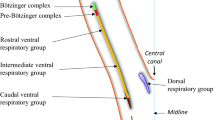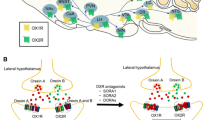Abstract
Olfactory bulbectomy (OBX) in rats causes several behavioral and neurochemical CNS changes, reminiscent of symptoms of human depression. Such depression-like behavior after OBX can be reversed with antidepressants. Recently, a connection between the vasopressin 1b (V1b) receptor and the development of depression has been suggested; therefore, a vasopressin V1b receptor antagonist (SSR149415) was investigated in the OBX model. Male rats received olfactory bulbectomy or sham surgery. After recovery, animals received 14 consecutive daily doses of SSR149415 (10 or 30 mg/kg), imipramine (20 mg/kg), or vehicle (5% hydroxy-propyl methylcellulose). Animals were tested in an open field after acute treatment, on days 7 and 14 of treatment and 1 week after cessation of treatment. Similar to imipramine, repeated, but not acute, administration of SSR149415 completely reversed OBX-induced hyperactivity, leaving activity in shams unaffected. This reversal of OBX-induced hyperactivity in the SSR149415 treated rats was still present 7 days after cessation of treatment. Although the behavioral effects of treatment with SSR149415 were specific for the OBX animals, adrenal gland weights were reduced in both sham and OBX animals treated with 30 mg/kg SSR149415. Chronic but not acute administration of SSR149415 normalizes OBX-induced hyperactivity up to 1 week after cessation of treatment, suggesting that a V1b receptor antagonist may have long-lasting antidepressant activity.


Similar content being viewed by others
References
Aguilera G, Rabadan-Diehl C (2000) Vasopressinergic regulation of the hypothalamic–pituitary–adrenal axis: implications for stress adaptation. Regul Pept 96:23–29
Alonso R, Griebel G, Pavone G, Stemmelin J, Le Fur G, Soubrie P (2004) Blockade of CRF1 or V1b receptors reverses stress-induced suppression of neurogenesis in a mouse model of depression. Mol Psych 9(3):278–286
Breuer M, Groenink L, Oosting R, Westenberg H, Olivier B (2007) Long term behavioral changes after cessation of chronic antidepressant treatment in olfactory bulbectomized rats. Biol Psychiatry 61(8):990–995
Caffé A, van Leeuwen F, Luiten P (1987) Vasopressin cells in the medial amygdala of the rat project to the lateral septum and ventral hippocampus. J Comp Neurol 261:237–252
Ebner K, Wotjak C, Landgraf R, Engelmann M (2000) A single social defeat experience selectively stimulates the release of oxytocin, but not vasopressin, within the septal brain area of male rats. Brain Res 872(1–2):87–92
Griebel G, Simiand J, Serredeil-Le Gal C, Wagnon J, Pascal M, Scatton B, Maffrand J, Soubrie P (2002) Anxiolytic- and antidepressant-like effects of the non-peptide vasopressin V1b receptor antagonist, SSR149415, suggest an innovative approach for the treatment of stress-related disorders. Proc Natl Acad Sci USA 99(9):6370–6365
Griebel G, Simiand J, Stemmelin J, Gal C, Steinberg R (2003) The vasopressin V1b receptor as a therapeutic target in stress-related disorders. Curr Drug Targets CNS Neurol Disord 2(3):191–200
Griebel G, Stemmelin J, Gal C, Serradeil-Le Soubrie P (2005) Non-peptide vasopressin V1b receptor antagonists as potential drugs for the treatment of stress-related disorders. Curr Pharm Design 11(12):1549–1559
Halbreich U (2005) Major depression is not a diagnosis, it is a departure point to differential diagnosis-clinical and hormonal considerations (A commentary and elaboration on Antonejevic’s paper). Psychoneuroendocrinology 31(1):16–22 author reply 23–24
Hashimoto K, Shimizu E, Iyo M (2004) Critical role of brain-derived neurotrophic factor in mood disorders. Brain Res Brain Res Rev 45(2):104–114
Hodgson R, Higgins G, Guthrie D, Lu S, Pond A, Mullins D, Guzzi M, Parker E, Varty G (2007) Comparison of the V1b antagonist, SSR149415, and the CRF1 antagonist, CP-154,526, in rodent models of anxiety and depression. Pharm Bio Behav 86(3):431–440
Hugin-Flores M, Steimer T, Schulz P, Vallotton M, Aubert M (2003) Chronic corticotropin-releasing hormone and vasopressin regulate corticosteroid receptors in rat hippocampus and anterior pituitary. Brain Res 976(2):159–170
Iijima M, Chaki S (2007) An Arginine vasopressin V1b antagonist, SSR149415 elicits antidepressant-like effects in an olfactory bulbectomy model. Prog in Neuro-Psychopharm Biol Psych 31:622–627
Jancsar S, Leonard B (1984) Changes in neurotransmitter metabolism following olfactory bulbectomy in the rat. Prog Neuro-Psychopharmacol Biol Psychiatry 8:263–269
Jarosik J, Legutko B, Unsicker K, von Bohlen und Halbach O (2007) Antidepressant-mediated reversal of abnormal behavior and neurodegeneration in mice following olfactory bulbectomy. Exp Neurol 204(1):20–28
Keck ME, Wigger A, Welt T, Muller MB, Gesing A, Reul JM, Holsboer F, Landgraf R, Neumann ID (2002) Vasopressin mediates the response of the combined dexamethasone/CRH test in hyper-anxious rats: implications for pathogenesis of affective disorders. Neuropsychopharmacology 26:94–105
Keilhoff G, Becker A, Grecksch G, Bernstein H, Wolf G (2006) Cell proliferation is influenced by bulbectomy and normalized by imipramine treatment in a region-specific manner. Neuropsychopharmacology 31(6):1165–1176
Kelly J, Wrynn A, Leonard B (1997) The olfactory bulbectomized rat as a model of depression: an update. Pharmacol Ther 74(3):299–316
Louis C, Cohen C, Depoortere R, Griebel G (2006) Antidepressant-like effects of the corticotropin-releasing factor 1 receptor antagonist, SSR125543, and the vasopressin 1b receptor antagonist, SSR149415, in a DRL-72s schedule in the rat. Neuropsychopharm 31(10):2180–2187
Lumia A, Teicher M, Salchli F, Ayers E, Possidente B (1992) Olfactory bulbectomy as a model for agitated hyposerotonergic depression. Brain Res 587(2):181–185
Marcilhac A, Anglade G, Hery F, Siaud Ph (1999) Olfactory bulbectomy increases vasopressin, but not corticotropin-releasing hormone, content in the external layer of the median eminence of male rats. Neurosci Lett 262(2):89–92
Masini C, Holmes P, Freeman K, Maki A, Edwards G (2004) Dopamine overflow is increased in olfactory bulbectomized rats: an in vivo microdialysis study. Physiol Behav 81(1):111–119
McEwen B, Olie J (2005) Neurobiology of mood, anxiety, and emotions as revealed by studies of a unique antidepressant tianeptine. Mol Psychiatry 10(6):525–537
Michopoulos I, Zervas IM, Pantelis C, Tsaltas E, Papakosta VM, Boufidou F, Nikolaou C, Papageorgiou C, Soldatos CR, Lykcuras L (2008) Neuropsychological and hypothalamic–pituitary-axis function in female patients with melancholic and non-melancholic depression. Eur Arch Psychiatry Clin Neurosci doi:10.1007/s00406-007-0781-8.
Murgatroyd C, Wigger A, Frank E, Singewald N, Bunck M, Holsboer F, Landgraf R, Spengler D (2004) Impaired repression at a vasopressin promoter polymorphism underlies overexpression of vasopressin in a rat model of trait anxiety. J Neurosci 24(35):7762–7770
Overstreet D, Griebel G (2005) Antidepressant-like effects of the vasopressin V1b receptor antagonist SSR149415 in the Flinders Sensitive Line rat. Pharm Biochem Behav 82:223–227
Ring RH, Malberg J, Li J, Lin Q, Schechter LE, Rosenzweig-Lipson S et al (2004) Neurochemical and behavioral characterization of a vasopressin V3 (V1B) antagonist. Society for Neuroscience, Washington, DC Program no. 354
Salome N, Stemmelin J, Cohen C, Griebel G (2006) Differential roles of amygdaloid nuclei in the anxiolytic- and antidepressant-like effects of the V1b receptor antagonist, SSR149415, in rats. Psychopharm 187:237–244
Scharfman H, MacLusky N (2006) Estrogen and brain-derived neurotrophic factor (BDNF) in hippocampus: complexity of steroid hormone-growth factor interactions in the adult CNS. Front Neuroendocrinl 27(4):415–435
Schatzberg A, Haddad P, Kaplan E, Lejoyeux M, Rosenbaum J, Young A, Zajecka J (1997) Serotonin reuptake inhibitor discontinuation syndrome: a hypothetical definition. Discontinuation Consensus panel. J Clin Psychiatry 58(suppl. 7):5–10
Serradeil-Le Gal C, Wagnon J, Simiand J, Griebel G, Lacour C, Guillong G et al (2002) Characterization of (2S,4R)-1-[5-oxo-2,3-dihydro1H-indol-3-yl]-4-hydroxy-N,N-dimethyl-2-pyrrolidine carboxamide (SSR149415), a selective and orally active vasopressin V1b receptor antagonist. J Pharmacol Exp Ther 300:1122–1130
Serradeil-Le Gal C, Wagnon J 3rd, Tonnerre B, Roux R, Garcia G, Griebel G, Aulombard A (2005) An overview of SSR149415, a selective nonpeptide vasopressin V(1b) receptor antagonist for the treatment of stress-related disorders. CNS Drug Rev 11(1):53–68
Sharif N (1988) Chemical and surgical lesions of rat olfactory bulb: changes in thyrotropin-releasing hormone and other systems. J Neurochem 50(2):388–394
Sheline Y (2003) Neuroimaging studies of mood disorder effects on the brain. Biol Psychiatry 54(3):338–352
Slotkin T, Cousins M, Tate C, Seidler F (2005) Serotonergic cell signaling in an animal model of aging and depressing: olfactory bulbectomy elicits different adaptations in brain regions of young adult vs. aging rats. Neuropsychopharmacology 30(1):52–57
Song C, Leonard B (2005) The olfactory bulbectomised rat as a model of depression. Neurosci Biobehav Rev 29(4–5):627–647
Surget A, Belzung C (2008) Involvement of vasopressin in affective disorders. Eur J Pharmacol 583(2–3):340–349
Van der Stelt H, Breuer M, Olivier B, Westenberg H (2005) Permanent deficits in serotonergic functioning of olfactory bulbectomized rats: an in vivo microdialysis study. Biol Psychiatry 57(9):1061–1067
Van Hoomissen J, Chambliss H, Holmes P, Dishman R (2003) Effects of chronic exercise and imipramine on mRNA for BDNF after olfactory bulbectomy in rat. Brain Res 974(1–2):228–235
Acknowledgements
The authors would like to thank Erik Hendriksen, Koen Westphal, Liesbeth Bijlsma, Monika Verdouw, and Hans Sturkenboom for their excellent technical assistance and animal upkeep.
Author information
Authors and Affiliations
Corresponding author
Rights and permissions
About this article
Cite this article
Breuer, M.E., van Gaalen, M.M., Wernet, W. et al. SSR149415, a non-peptide vasopressin V1b receptor antagonist, has long-lasting antidepressant effects in the olfactory bulbectomy-induced hyperactivity depression model. Naunyn-Schmied Arch Pharmacol 379, 101–106 (2009). https://doi.org/10.1007/s00210-008-0336-1
Received:
Accepted:
Published:
Issue Date:
DOI: https://doi.org/10.1007/s00210-008-0336-1




